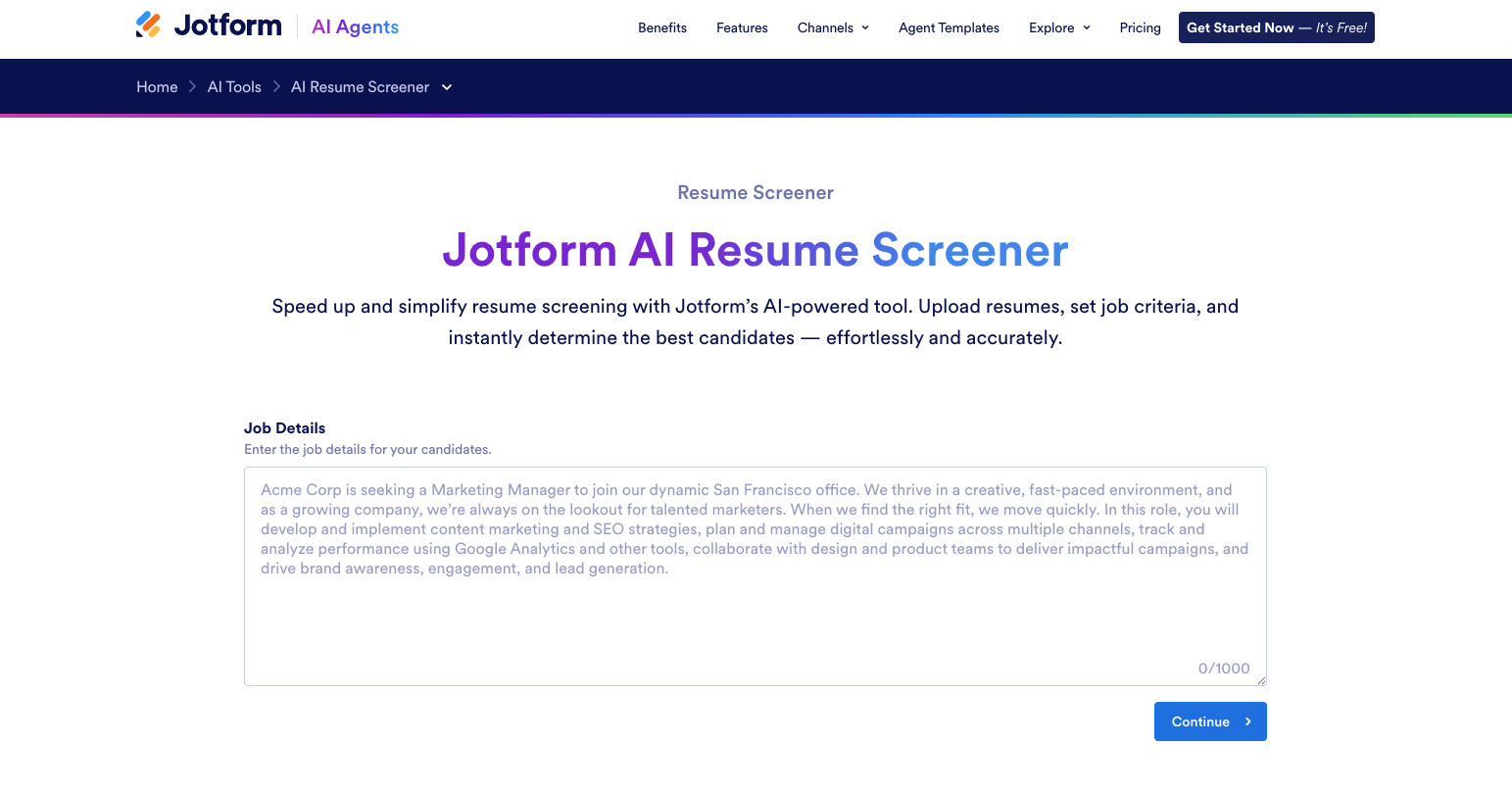7 proven methods to screen resumes
- Initial quick scan
- Set up a clear resume scoring system
- Use Boolean search techniques
- Batch review for efficiency
- Standardize prescreening questionnaires
- Check for customized resumes
- Account for overall impression without bias
Hiring the right person is tough. For recruiters, it feels like there simply aren’t enough hours in the day. Between the flood of job applications, the need to fill roles quickly, and the pressure of finding that perfect fit, resume screening can seem like panning for gold, sifting through heaps of mud to find one shiny nugget.
Whenever anyone posts a job opening, responses pour in. The key is figuring out how to spot the best candidates quickly, fairly, and with less stress. That’s where streamlined strategies, automation, and AI tools come into play.
In this post, I’ll walk you through proven ways to screen resumes effectively in 2025, from tried-and-true manual methods to smart recruiting technology. I’ll also look at the future of resume screening and how an easy-to-use tool like Jotform’s AI Resume Screener makes the process faster and more accurate than you ever thought possible.
Get ready to spend less time sifting and more time interviewing your future star employees.
What does it mean to screen resumes effectively?
Resume screening is one of the most critical steps in the recruitment process. At its core, it’s about narrowing the pile of applicants to the ones most likely to succeed in your role. You’re not making any hiring decisions during this first pass, but you want to focus your attention where it counts.
The goal is simple: Quickly identify qualified candidates while minimizing bias and mistakes. That requires a clear, well-written job description, a consistent set of evaluation criteria (with standards like specific skills, years of experience, and certifications that are relevant to the job), and a structured resume screening process you can reliably repeat.
Without these pieces in place, it’s easy to get distracted and let unconscious bias creep in.
Common pitfalls during resume screening include
- Leaning too heavily on “gut instinct” instead of structured comparisons
- Unconscious bias that creeps into judgments about names, schools, or career paths
- Being overly rigid (for example, rejecting someone for missing one keyword when they have all the other relevant skills)
- Not scaling the screening process to the role (for example, entry-level positions may get flooded with resumes and need harsher filters up front, while senior-level roles might merit more nuanced review)
Proven methods to screen resumes
When you’re faced with a pile of resumes, where do you begin? The best resume screening process is one that’s fair, accurate, efficient, and repeatable.
Although every recruiter develops their own style for screening resumes, certain methods work consistently across industries. Here are the most effective resume screening methods:
- Initial quick scan: Use a 30-second skim to filter out unqualified resumes. Check for minimum qualifications in education and experience. Weed out resumes with dealbreakers like obvious mistakes, frequent job-hopping, unexplained gaps, formatting issues, spelling errors, or missing qualifications before you even begin your detailed review.
- Set up a clear resume scoring system: Assign numerical values to key criteria, such as years of experience, skills, and relevant certifications. For example, a candidate with five years of project management experience might get five points, while a candidate with none gets zero. This system helps you objectively compare candidates and reduces guesswork.
- Use Boolean search techniques: If you’re dealing with digital files in email or a shared drive and don’t have access to an applicant tracking system (ATS), a Boolean search (using AND, OR, NOT operators) will filter resumes by keyword. For example, searching “Java AND Python” will pull candidates with both skills, while “marketing NOT sales” weeds out irrelevant results and “Salesforce OR HubSpot” finds experience with either CRM.
- Batch review for efficiency: Rather than spending too much time reviewing resumes one at a time, scan them in batches. Start with a quick round of eliminating resumes with major red flags before you go deeper. This way, you avoid fatigue from reading dozens of unqualified resumes in a row.
- Standardize prescreening questionnaires: Why not let candidates self-qualify? A short online form or questionnaire can spot dealbreakers before you waste time on a dead-end interview. You can ask about criteria like years of experience, certifications held, or willingness to relocate.
- Check for customized resumes: Prioritize candidates who tailor their resumes to the job description, which shows dedication and attention to detail.
- Account for overall impression without bias: Sometimes a resume “feels” promising, but you don’t want to let bias around names, schools, or ages unfairly sway your hiring decision. Consider the tone, presence of specific achievements, and relevance of skills without letting unconscious bias affect decisions.
A multi-layered approach works best. By combining these methods, you’ll save time, reduce noise, and ensure only qualified candidates make it to your interview shortlist.
Leveraging technology: Tools to screen resumes efficiently
Manual screening simply won’t work when you’re getting hundreds or thousands of resumes. Fortunately, you’re not on your own. Modern technology can help in three crucial ways with screening resumes, making the process faster and more precise.
Applicant tracking systems
An ATS resume screening process allows recruiters to organize resumes, track candidates, and filter applications by keywords or specific criteria.
When you get a new resume submission, the ATS software application automatically parses it, pulling out key information like name, contact info, and work history. This is all stored in a structured database, so it’s easy to search, filter, and sort candidates based on defined keywords or qualifications.
Instead of leaving you drowning in PDFs, an ATS can score and rank applicants, automatically showing you a suitable short list. This is particularly helpful for high-volume roles, as it keeps a resume database structured and searchable.
AI-powered resume screening tools
The newer wave of tools goes beyond mere organization, using machine learning algorithms to analyze and score resumes in a more sophisticated way.
An AI resume screening process matches applicants against your job description and flags inconsistencies. Other benefits include
- Faster sorting
- ATS integration
- Candidate scoring
- Smart keyword matching
- Reducing human error and bias
A good AI resume screening tool speeds up the entire resume screening process by highlighting a candidate’s most relevant skills and experience — that way, you don’t have to hunt for these. Look for tools that offer AI-powered filtering, resume parsing, customizable criteria, and seamless integration with your existing ATS or other recruitment software.
Other popular tools
Tools like Peoplebox.ai, Freshteam, and Zoho Recruit give recruiters more ways to streamline hiring. They’re part of a growing ecosystem of recruitment automation designed to simplify the repetitive parts of screening resumes. These platforms emphasize different strengths and parts of the hiring funnel, all with the same result: Recruiters now have a tech stack to rival any sales or marketing team.
Introducing Jotform’s AI Resume Screener: An easy and efficient AI solution
Jotform’s easy-to-use AI-powered tool automates resume screening and quickly matches you with qualified candidates based on job requirements. Jotform’s AI Resume Screener is designed for teams that want fast, reliable results without juggling multiple systems.
Key features
- Simple setup and integration
- Customizable to your job criteria
- Cuts down manual review time from hours to minutes
- AI-driven analysis to highlight skills and experience that matter most for your roles
You simply create your job criteria, and the AI takes over. When you upload a pile of resumes, the tool instantly analyzes each one, highlighting key skills and experience that match what you’re looking for. It even gives each candidate a score, so it’s easy for you to rank and compare them. This is an effective solution for teams of all sizes, especially those without a complex ATS.
For recruiters and hiring managers, the benefits are clear:
- Save time and streamline your workflow: Instead of spending hours reading every word of every resume, you can review a few of the most relevant summaries.
- Improve accuracy and consistency: The AI uses the same objective criteria every time, so you can be sure every candidate is being evaluated fairly.
- Reduce bias and human error: The tool focuses only on skills and experience, ignoring personal details that could lead to unfair judgments.
Jotform’s AI Resume Screener is especially helpful for startups or HR teams without expensive enterprise systems. When you have more consistent decision-making, you have more time to focus on building relationships with top candidates.
Want to see for yourself? Try Jotform’s AI Resume Screener today and discover how it can transform your hiring process.
Resume screening FAQ
The answer to this question can vary wildly. While some people go by the 10-second rule, I recommend going a little longer with at least a 30-second skim to filter out unqualified resumes. Some studies say recruiters spend an average of just six seconds on a resume.
The goal of an initial scan is to quickly review the information and catch red flags, but it’s often part of a more extensive process. When you factor in detailed reviews, scoring, and follow-ups, resume screening can take hours or even days, especially if a job opening attracts a lot of applications. This is why using resume screening software and other tools to automate the process makes such a difference.
Yes, all resume screening practices must comply with equal employment opportunity laws and avoid discrimination.
Always evaluate your candidates based on objective, job-related criteria, such as skills, experience, and education. Never make decisions based on protected characteristics like age, race, gender, religion, or disability.
Be sure to document your screening process, implement a standardized scoring system, and use an automated resume screening tool that focuses only on relevant data. These tips help you maintain consistency and fairness, which can, in turn, help you avoid legal issues.
The simplest methods for verifying resumes include reference checks, credential verification, and background check services. When it comes to skills assessments, some recruiters rely on prescreening tests or short projects/mock assignments to confirm a candidate’s skills are a good match.
Find your perfect candidates with Jotform
The sheer volume of applicants in today’s market can be overwhelming, but resume screening doesn’t have to (and shouldn’t) feel like digging for a needle in a haystack.
When you combine proven methods like quick scans, scoring systems, and pre-screening questionnaires with modern tools like ATS and AI, you set yourself up to find the best candidates quickly and fairly. A hybrid approach unites human-centric methods with powerful AI in HR tools for the best results. With this duo on your side, you can overcome recruitment challenges and transform your hiring workflow into a seamless operation.
Automation is the real game-changer. Tools like Jotform’s AI Resume Screener simplify the entire process, saving time while improving accuracy. These tools can automate the tedious parts of the process, so you can focus on what matters most: connecting with the people who will help your company succeed.
Ready to spend less time staring at resumes and more time welcoming the right people to your team? Contact us to learn how.
This article is for HR professionals, hiring managers, recruitment specialists, and anyone who wants to streamline their recruitment process by efficiently screening resumes using best practices and AI-powered tools.




































Send Comment: